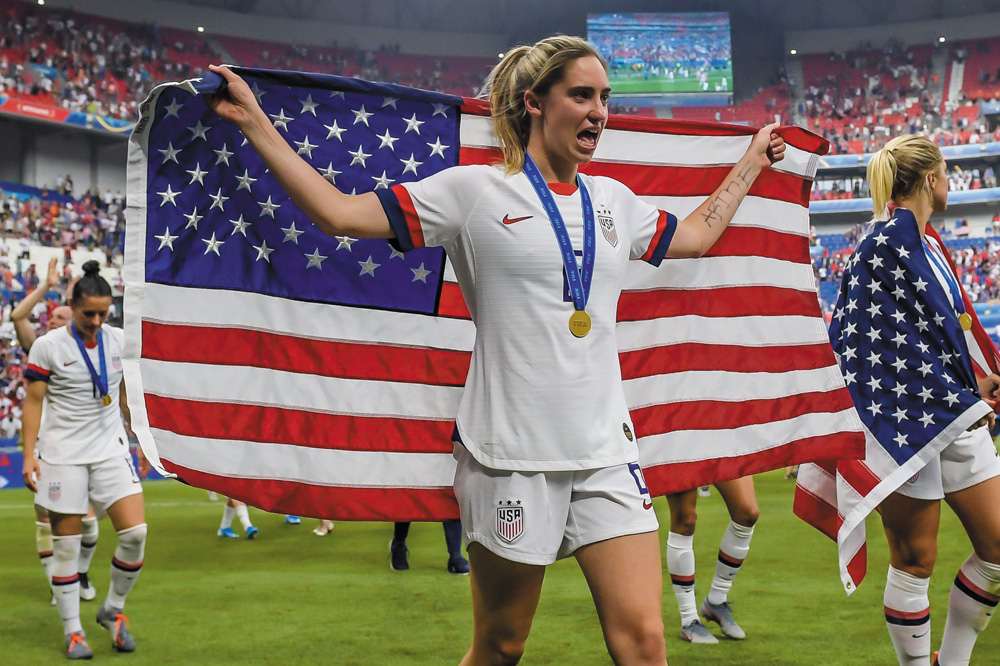Three Wahoos and their coach win the Women’s World Cup

In the 55th minute of the 2019 Women’s World Cup final, U.S. Women’s National Team defender Becky Sauerbrunn (Col ’08) sustained a minor head wound when she collided with a player from the Netherlands. The UVA soccer alumna left the field; two minutes later, she was ready to resume playing with a small bandage on her head and blood dripping down her face. The internet went wild, including a tweet that shouted: “BECKY SAUERBRUNN IS MY NEW PRESIDENT.”
After the July 7 game, Sauerbrunn noted that she hadn’t seen the laudatory tweets—she’d been a little social media shy throughout the tournament—“but, hey, put me on the ticket!” she said, laughing.
Close to 20 million viewers watched her and the rest of the U.S. Women’s National Team beat the Netherlands 2-0 that day, making it the most-watched soccer match in the U.S.—men’s or
women’s—since the 2015 Women’s World Cup final.
She wasn’t the only UVA women’s soccer player on the squad; competing alongside her were Emily Sonnett (Col ’15) and Morgan Brian (Educ ’17), as well as UVA women’s head coach Steve Swanson, who served as an assistant coach as the team competed for—and won—its fourth World Cup title.

It was no easy run. Before the tournament, pundits questioned whether the top-ranked U.S. team could repeat its 2015 title. “There were question marks,” says first-time World Cup player Sonnett, who started one game.
“We had ups and downs leading into the tournament, where we were trying different formations and different personnel on the field,” says Sauerbrunn, who started her second World Cup (and played in her third). Sauerbrunn noted how, in January, the U.S. had lost to France, 3-1, which the team saw as “a wake-up moment where we all had to come together and buy into a role where you knew it was important to the success of the group.”
That mindset worked. Throughout the tournament, the U.S. women’s team earned hard-fought victories, including beating the talented French squad, in France, in the quarterfinals.
For Brian, a midfielder who has struggled with injuries in recent years and didn’t play as many minutes in this World Cup run as in the previous one, being part of the team was still monumental. Brian was the youngest member of the 2015 World Cup squad, where she played all 90 minutes of the final; while she had more experience heading into 2019, she knew that no matter her role (she started one game in this year’s tournament), she’d still make a mark.
“To see the impact we’ve had on women and this country beyond soccer and the workplace—it’s really inspiring to know that this country is moving forward,” Brian says. “That’s something to be proud of—we are going to be a part of history beyond soccer.”

For Sauerbrunn, who started six of seven matches for the U.S. while anchoring the team’s powerful defense, this experience brought a new intensity. “Our path was more difficult than it was in 2015—it seemed like every game ramped up,” she says. “2015 started difficult and then the middle parts were crazy. 2019 was just a steady climb of playing the world’s best teams.”
That defense, which was seen as the team’s biggest question mark heading into the tournament, gave up only three goals throughout.
“To stand strong against France, Netherlands and England ... I’m really proud that these players stepped up and changed the narrative—really seizing the moment and owning it,” Sauerbrunn says.
As the team seized the moment in front of tens of millions on the field, the women unified off the field as well. In March, all 28 members of the USWNT, including the three former Wahoos, filed a class-action lawsuit against the U.S. Soccer Federation, claiming gender discrimination and seeking equal pay to that of their male counterparts. The soccer federation denied the allegations of discrimination, and the women and U.S. Soccer agreed to mediation, which then broke down in mid-August. The case will now likely go to trial.
As Sauerbrunn told reporters the day after the team won the final: “Even if you double the prize money, the gap is still as big as it’s ever been, if not bigger, so that’s a huge problem. This tournament has shown that a lot of people are watching this game—they’re watching women’s soccer—so I think they need to find some way to capitalize on that and pay the women what I think they are very deserving of.”
Fans’ support of the women has been clear. Several supporters held up posters reading “equal pay” at the team’s championship parade in New York City, and notables such as U.S. Sen. Kamala Harris and Snoop Dogg have voiced support for the women on social media.
“Realizing that, wow, we have a platform to do something—a lot of the girls are using this platform, whether that changes the conversation or whatnot,” Sonnett says. “Seeing companies and other things they’re saying, let’s keep supporting not just the 23 players, but the league—it’s a group effort and everyone has a part.”